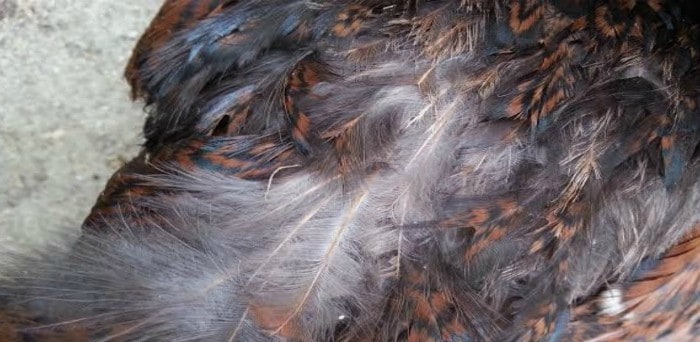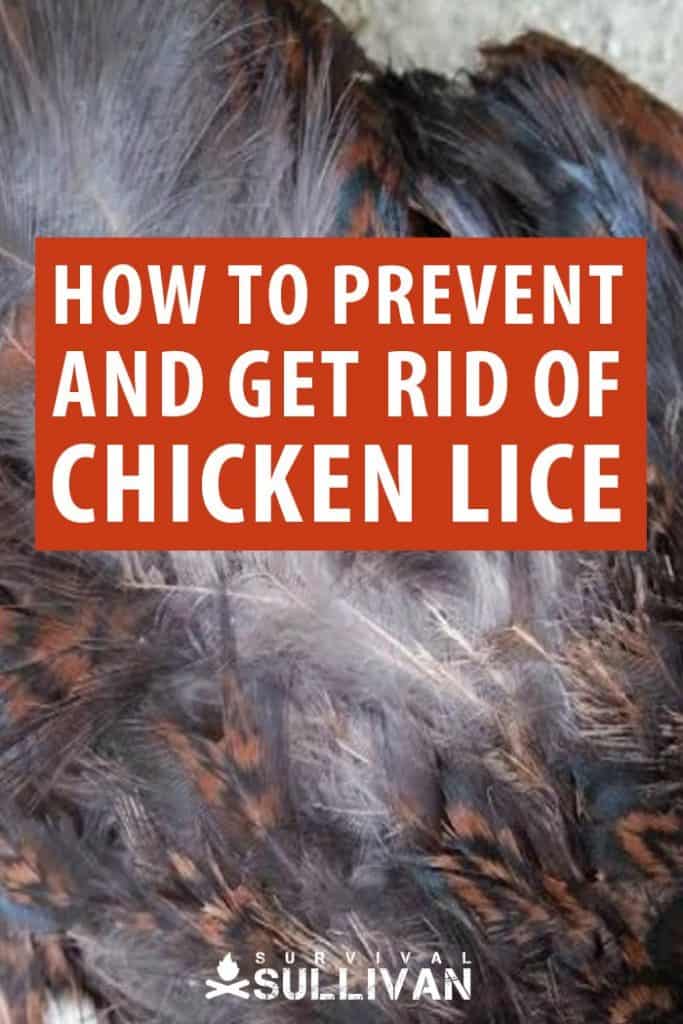Chicken lice are not anything that any chicken keeper wants to deal with. Unfortunately, in some cases, they can be tough to prevent.

It might seem like no matter how diligently you clean your coop or how meticulously you care for each and every chicken… you keep getting chicken lice. And they keep coming back and wreaking havoc on your flock.
Luckily, knowing some easy ways to get rid of lice can help prevent this pest from becoming a frequent scourge on your farm. Here are some tips to get rid of chicken lice- fast and easy – so that you and your chickens can finally be at ease.
What Are Chicken Lice – And How Do They Get On My Chickens?
The Two Types of Chicken Lice:
- Body Lice
- Shaft Lice
Chicken lice are tiny, flat insects with six legs. They look a lot like the life you may have seen if your children were fortunate to come home from school with an infestation!
Like human lice, chicken lice lay eggs at the base of a chicken’s feathers (instead of how human lice lay eggs in your hair).
Adults then live on the skin of the chicken. Chicken lice have a narrow lifespan, usually living only about 24 days.
However, they can lay a ton of eggs at once, continuing the life cycle until it becomes unbearable for your chickens to deal with.
Chicken lice usually end up on chickens after they come into contact with wild birds. If your chickens free range to spend a lot of time outdoors, they are, unfortunately, just as likely to get lice as chickens that live indoors.
Unfortunately, this is one of those problems that can be eliminated entirely by good animal husbandry!
Signs of a Chicken Lice Infestation
There are several signs that your chickens have lice. Many of these symptoms occur with other illnesses, too, so make sure it’s chicken lice causing the problem before you enact any treatments.
You might notice, for example, that your chickens move more slowly or begin to lose weight.
You might find that your chickens’ combs become lighter in color, or that there are rough-looking feathers that are becoming discolored. Your chickens might engage in excessive preening, too.
Your chicken might have dirty feathers near its vent, and egg production might drop off, too.
Your chickens might eat less or begin pulling at their own feathers. These kinds might look scaly or irritated, even to the point where you notice bald spots on your bird.
A bad enough infestation will make it possible for you so see the bugs crawling on the skin or feathers, too.
While a chicken lice infestation isn’t usually fatal, it can be incredibly annoying for your chickens to have to deal with.
You may notice a serious loss in egg production and, if left untreated, the anemia caused by lice can even kill your chickens.
It’s also important to note that lice eggs generally hatch about once a week or every ten days – so you may notice these kinds of symptoms repeating themselves indefinitely.
There are two main types of chicken lice – body lice and shaft lice.
Body chicken lice are usually easiest to detect by parting the feathers of a bird. You should be able to see the egg clusters near the base of the feather, typically by the breast, vent, and thigh.
Shaft lice are smaller than body lice. These are usually laid along the feather shaft, as you might guess from the name. These are also relatively easy to identify upon inspection.
How to Prevent Chicken Lice
Closely Examine New Arrivals
Once chicken lice get into your flock, they’re going to be tough to get rid of. Therefore, one of the easiest ways to prevent chicken lice is to inspect each new arrival to the coop.
Go through their feathers to make sure they don’t have any nasty bugs hanging out!
Limit Contact with Wild Birds
You may not have much control over the wild birds that fly over your property, but there are some steps you can take to reduce the likelihood that your chickens will come into contact with other birds
For one, make sure your chicken feed is locked up securely so that wildlife won’t be attracted to it. This serves many other benefits, too, of course, namely that you won’t be drawing predators to your property!
You can also make your coop inhospitable for wild birds to land on. Consider eliminating nearby water sources like standing water and birdbaths, and add some spike strips to the top of your coop to create more of an obstacle.
Watch Your Broody Hens
Broody hens are more likely to develop chicken lice infestations than non-broody hens.
Why?
They don’t get up and dust themselves off as often as regular chickens do. They can be more susceptible to getting parasites, particularly if your nest boxes are infested, so make sure you check them often.
Set Up Dust Baths
If your chickens develop and suffer from chicken lice, one of the best ways to prevent future outbreaks is to set up dust baths. If you don’t already have dust baths for your chickens, you – and your flock! – are missing out.
Dust baths not only let your chickens groom themselves effectively, but they also serve as a social outing for your birds. They’ll love preening themselves in the dust baths and doing so in the company of their friends!
You can take your dust bath to the next level by adding a pinch of diatomaceous earth.
You can also add wood ash, both of which will help repel lice. Just make sure your dust bath is protected from the rain, as ash doesn’t hold up well to wet weather.
How to Get Rid of Chicken Lice
Clean the Coop
Your first step in combating a chicken lice outbreak should be to thoroughly clean the chicken coop. Remove everything, including nesting boxes and roost bars (if you can) along with feeders and waterers.
Give the coop a good scrub down with soap, water, and vinegar. Let everything dry, and avoid putting new bedding down for at least one hour.
You can also use things like a high-pressure hose, boiling water, and dehydrated lime to wash your coop – just make sure you give it plenty of time to clear out.
Do not let your chickens back into the coop until you have scrubbed everything and applied a layer of diatomaceous earth to the coop.
Give the coop at least two to three hours to dry out, and for the lice to evacuate until you let your chickens back in.
Apply Wood Ash or Diatomaceous Earth
Just as you would apply diatomaceous earth to the chicken coop, you can also apply it directly to your chickens. This can help kill lice that are directly on their skin.
You can also use dish soap to help get the lice off your birds. Make sure you wash your chickens gently, though, as their skin will likely be raw and sensitive from the lice.
Watch Out For Anemia
Unfortunately, one of the biggest problems with lice is that they have a tendency to cause your chickens to become anemic. This is because they are drawing on your bird’s blood supply.
Watch out for signs of anemia (like weakness and lethargy), and supply your girls with some iron-rich snacks, like raw red meat. This will help give them strength they need to fight the lice.
In addition to supplying extra iron, it’s also a good idea to supply additional protein. This will give your chickens a way to fight the infection along with some extra energy.
Some treats you might want to consider include:
- Pumpkin seeds
- Spinach
- Peas
- Scrambled eggs
Make a Coop Mite Spray
Another natural remedy you can try is to make a natural mite spray. This will not only get rid of lice but can also be effective against other types of chicken mites, too.
You can buy a mite spray, but a more organic version will include equal parts of dish soap, oil, and water. Add to a spray bottle, and apply liberally to the coop and run.
Try Neem Seed Oil
Neem seed oil can be purchased at most gardening centers, and is highly effective when applied in a spray bottle. Just mix two liters of water with one tablespoon of neem oil.
You can apply the spray directly to your coop along with your chickens.
Use Garlic
Garlic is an excellent anti-parasite treatment that works well on both internal and external parasites (lice included).
You should add a bit of garlic juice to your chicken’s diet, which will help repel parasites, or you can make a spray of garlic juice and water (along with optional essential oils, like lavender), and spray it on your coop or your chickens themselves.
Reinspect Your Chickens
Once you’ve given the coop a good cleaning and have applied the diatomaceous earth treatment, you’ll want to wait a week, and then re-inspect your chickens.
You may have to keep treating your chickens for up to four weeks to make sure the treatments are effective, as it takes some time for the lice eggs to hatch and go through their lifecycle.
Are There Chemicals That Can Get Rid of Chicken Lice?
If you’ve tried all of the methods listed above and still aren’t seeing a letup in your chicken lice population, know that there are some chemicals you can use to repel them.
However, I don’t necessarily recommend them.
Although chemical treatments like Sevin dust work quickly, they are incredibly caustic. They can kill bees and other beneficial organisms, and they can easily get into your garden and contaminate your produce, too.
Some chicken keepers have reported that they suffered from symptoms like fever hives, and coughing when applying this treatment, too – even when wearing a mask.
Ideally, you should try some of the preventative methods above before resorting to chemical treatments. With a bit of prevention and some attentiveness when it comes to dealing with your flock, you will hopefully never have to worry about chicken lice – or other pests – in your coop.


Although I teach high school English by day, I’m also the proud co-owner of a small, twenty-two acre property in New York (my second job and favorite pastime). We raise chickens, pigs, bees, and vegetables on our “homestead” and are proud to call our little slice of heaven home! When I’m not wrangling chickens or harvesting massive quantities of zucchini, I enjoy writing about common homesteading topics and other subjects.

Thanks so much for this article. We are expecting our first family of chickens soon and these helpful hints will go a long way in helping out if some outbreak of lice comes up. I love that you use natural substances.
I have raised chickens for many years . I agree with this article . I only had lice one time. Out of 50 years of dealing with chickens. An old guy down the road had me use black leaf 40. This was in 1971. I do not know what it was but it worked.
Thank you so much for this article. Just found a few lice on several of our chicken and cat. Thankfully there isn’t anything severe on the chicken’s skins. Getting our natural remedies ready.